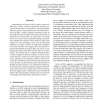Free Online Productivity Tools
i2Speak
i2Symbol
i2OCR
iTex2Img
iWeb2Print
iWeb2Shot
i2Type
iPdf2Split
iPdf2Merge
i2Bopomofo
i2Arabic
i2Style
i2Image
i2PDF
iLatex2Rtf
Sci2ools
CSB
2005
IEEE
2005
IEEE
Temperature and Mutation Switches in the Secondary Structure of Small RNAs
Conformational switching in the secondary structure of RNAs has recently attracted considerable attention, fostered by the discovery of ‘riboswitches’ in living organisms. These are genetic control elements that were found in bacteria and offer a unique regulation mechanism based on switching between two highly stable states, separated by an energy barrier between them. In riboswitches, the energy barrier is crossed by direct metabolite binding, which facilitates regulation by allosteric means. However, other event triggers can cause switching to occur, such as single-point mutations and slight variations in temperature. Examples of switches with these event triggers have already been reported experimentally in the past. Here, our goal is to computationally design small RNA switches that rely on these triggers. Towards this end, our computer simulations utilize a variety of different similarity measures to assess the distances between an initial state and triggered states, based o...
| Added | 24 Jun 2010 |
| Updated | 24 Jun 2010 |
| Type | Conference |
| Year | 2005 |
| Where | CSB |
| Authors | Assaf Avihoo, Danny Barash |
Comments (0)

